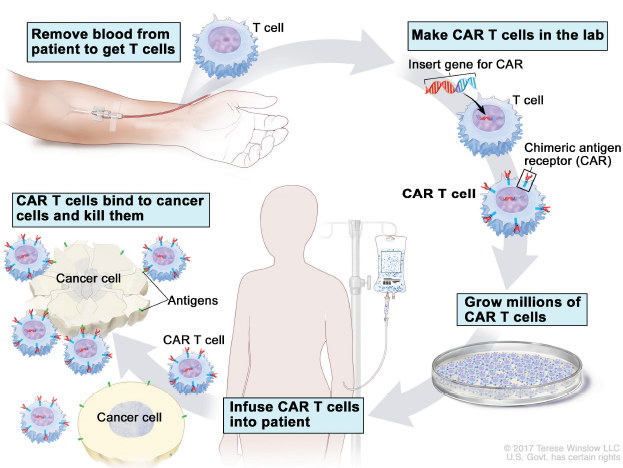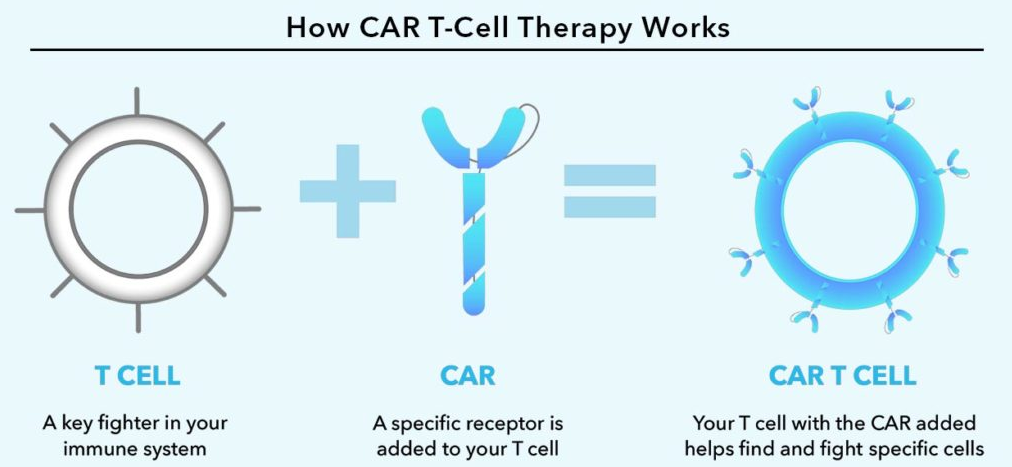The cost of CAR T-cell therapy typically ranges from $350,000 to over $475,000 per patient in the United States, reflecting its complex and personalized nature.
Introduction to CAR T-Cell Therapy
CAR T-cell therapy represents a significant advancement in cancer treatment, harnessing the body’s immune system to combat cancer cells. This revolutionary approach involves reprogramming the patient’s T-cells, a type of immune cell, to recognize and attack cancer cells. It’s particularly effective against certain types of blood cancers, such as acute lymphoblastic leukemia and non-Hodgkin lymphoma.
Overview of CAR T-Cell Therapy
CAR T-cell therapy begins with the extraction of T-cells from the patient. These cells are then genetically engineered in a laboratory to produce special structures called chimeric antigen receptors (CARs) on their surface. When reintroduced into the patient’s body, these CARs enable T-cells to recognize and destroy cancer cells. The effectiveness of this therapy has been demonstrated in various clinical trials, showing remarkable results in patients who had limited treatment options.

Historical Development of CAR T-Cell Therapy
The concept of CAR T-cell therapy emerged in the late 1980s, with significant progress made over the decades. The first successful clinical trials were conducted in the early 2000s, leading to the approval of the first CAR T-cell therapies by regulatory agencies like the FDA in the late 2010s. These approvals marked a milestone in cancer treatment, offering new hope to patients with certain types of advanced cancers.
Key Components of CAR T-Cell Treatment
The key components of CAR T-cell treatment include the T-cells themselves, the viral vectors used for genetic engineering, and the growth mediums for cell cultivation. Each component plays a crucial role in the therapy’s success. The reprogramming of T-cells is a complex process, requiring precision and expertise. The cost of treatment can be significant, often reaching several hundred thousand dollars per patient. This cost reflects the specialized nature of the treatment, the advanced technology required, and the personalized approach to each patient’s therapy.
In this treatment, the efficiency, efficacy, and quality of the reprogrammed T-cells are paramount. The success rate of CAR T-cell therapy varies depending on factors like cancer type and stage, but it has shown promising results in many cases. The lifespan of the modified T-cells in the patient’s body can also impact the long-term effectiveness of the treatment.
The main advantage of CAR T-cell therapy lies in its targeted approach, which can reduce the side effects typically associated with conventional cancer treatments. However, it also has its drawbacks, including the potential for severe immune reactions and the high cost of treatment. Despite these challenges, the value of CAR T-cell therapy in treating certain cancers is undeniable, and ongoing research continues to improve its efficacy and accessibility.
Understanding the Cost of CAR T-Cell Therapy
The cost of CAR T-cell therapy is a critical factor affecting its accessibility and adoption. This innovative treatment, while highly effective for certain cancers, comes with a significant price tag, often exceeding several hundred thousand dollars per patient. Understanding the components of this cost is essential for patients, healthcare providers, and policymakers.
Factors Influencing the Cost
Several factors contribute to the high cost of CAR T-cell therapy. These include the expenses involved in research and development, the complexity of the manufacturing processes, and the personalized nature of the treatment.
Research and Development Expenses
The development of CAR T-cell therapies involves extensive research and experimentation, often spanning many years. The costs associated with clinical trials, regulatory approvals, and intellectual property protections are substantial. This prolonged and expensive process significantly contributes to the overall cost of the therapy.
Manufacturing Processes
Manufacturing CAR T-cells is a complex and labor-intensive process. It requires highly specialized facilities and skilled personnel. The process of genetically modifying and expanding T-cells must be done under strict quality control and sterile conditions, which adds to the cost.
Treatment Customization
Each CAR T-cell therapy is tailored to the individual patient, adding another layer of expense. The process involves extracting the patient’s T-cells, modifying them in the lab, and then reinfusing them into the patient. This personalized approach ensures high treatment efficacy but also contributes to the high cost.

Comparative Cost Analysis with Other Cancer Treatments
When compared to traditional cancer treatments like chemotherapy, radiation, and surgery, CAR T-cell therapy is generally more expensive. However, its potential for a one-time treatment offering long-lasting remission, in some cases, can offset its initial high cost over time.
Case Studies: Cost Analysis in Different Countries
The cost of CAR T-cell therapy varies significantly across different countries. In the United States, the price can range from $350,000 to over $475,000, not including additional costs like hospital stays and supportive care. In contrast, some European countries negotiate lower prices for these therapies, making them more accessible. For example, in the UK, the National Health Service has negotiated prices with manufacturers, although the exact figures are often confidential.
Insurance and Financial Assistance for CAR T-Cell Therapy
Navigating the financial aspects of CAR T-cell therapy is as crucial as understanding its medical benefits. Given the high cost of treatment, insurance coverage and financial assistance programs play a pivotal role in making this therapy accessible to patients.
Insurance Coverage for CAR T-Cell Therapy
Insurance coverage for CAR T-cell therapy varies widely depending on the provider and the plan. In the United States, most major insurance companies and Medicare cover this therapy for approved indications. However, coverage can depend on specific criteria such as the type and stage of cancer. Patients often need to undergo a pre-authorization process to confirm coverage. Insurance typically covers a significant portion of the treatment cost, but the extent of coverage can vary, leaving patients with variable out-of-pocket expenses.
Government and Private Financial Aid Programs
Several government and private programs offer financial assistance to patients undergoing CAR T-cell therapy. For instance, in the U.S., Medicaid may cover the therapy for eligible individuals. Additionally, pharmaceutical companies that develop CAR T-cell therapies often have patient assistance programs offering financial support to those who qualify. Non-profit organizations also provide grants and aid to help with expenses not covered by insurance.
Out-of-Pocket Costs for Patients
Despite insurance coverage and financial aid, patients often face substantial out-of-pocket costs. These can include co-pays, deductibles, and other expenses not covered by insurance, like travel and lodging if treatment is not available locally. The total out-of-pocket cost can vary greatly but may range from a few thousand to tens of thousands of dollars. Patients need to consider these costs when planning for treatment.
Economic Impact of CAR T-Cell Therapy
The economic impact of CAR T-cell therapy extends beyond individual treatment costs, influencing healthcare systems and economies at large. This innovative treatment, while offering potential cures for certain cancers, comes with significant financial implications.

Long-term Cost-effectiveness of CAR T-Cell Therapy
Evaluating the long-term cost-effectiveness of CAR T-cell therapy involves comparing its high upfront costs against potential long-term benefits. For some patients, this therapy can lead to sustained remission where other treatments have failed, potentially reducing the need for ongoing cancer treatment and associated costs. Studies suggest that despite its high initial price, CAR T-cell therapy could be cost-effective over time, particularly if it leads to a significant reduction in recurrent hospitalizations and treatments.
Impact on Healthcare Systems
The high cost of CAR T-cell therapy can strain healthcare budgets, particularly in systems that provide universal healthcare coverage. These systems must balance the high cost of a single treatment against the benefits of potentially curing a previously untreatable condition. In some cases, the adoption of CAR T-cell therapies has led to the need for budget increases or reallocation of resources within healthcare systems.
Future Economic Projections for CAR T-Cell Therapy
As research continues and more applications for CAR T-cell therapy are discovered, its economic impact is likely to grow. Future projections suggest that with increased demand, there might be a drive towards cost reduction through improved manufacturing processes and economies of scale. Additionally, as patents expire and more competitors enter the market, prices may decrease. However, the overall financial impact on healthcare systems will depend on the balance between these cost reductions and the increasing number of patients eligible for therapy.
Challenges and Future Directions in Cost Management
The high cost of CAR T-cell therapy poses significant challenges, prompting a need for strategies to manage and reduce these expenses. Innovations in technology and policy changes are crucial in shaping the future affordability of this groundbreaking treatment.
Reducing the Cost of CAR T-Cell Therapy
Efforts to reduce the cost of CAR T-cell therapy focus on streamlining the manufacturing process and enhancing the efficiency of production. Simplifying the cell engineering process or finding more cost-effective methods of cell expansion could significantly lower production costs. Additionally, developing off-the-shelf CAR T-cell products, as opposed to patient-specific treatments, could lead to reduced costs due to economies of scale.

Technological Innovations and Their Impact on Costs
Technological advancements play a critical role in cost reduction. Automation of cell processing, improvements in genetic engineering techniques, and advancements in bioreactor designs can increase the efficiency and yield of CAR T-cell production. These innovations not only have the potential to lower costs but also improve the quality and consistency of the therapy, enhancing its overall value.
Policy Changes and Their Implications for Treatment Affordability
Policy changes can also significantly impact the affordability of CAR T-cell therapy. Governments and regulatory bodies can influence pricing through price negotiations, reimbursement policies, and incentives for research and development. For instance, implementing value-based pricing models, where the price of therapy is tied to its effectiveness, could make these treatments more accessible while encouraging continuous improvement in treatment efficacy.